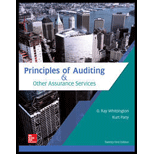
Principles Of Auditing & Other Assurance Services
21st Edition
ISBN: 9781259916984
Author: WHITTINGTON, Ray, Pany, Kurt
Publisher: Mcgraw-hill Education,
expand_more
expand_more
format_list_bulleted
Question
Chapter 9, Problem 4RQ
To determine
Suggest the option which would be opted in case of random sampling.
Expert Solution & Answer
Want to see the full answer?
Check out a sample textbook solution
Students have asked these similar questions
Solve this general accounting problem
On January 1, 2025, Wages Payable was $47,000. Wages Expenses for 2025 totaled $453,000. The ending balance of Wages Payable was $59,000. What is the amount of cash paid for wages in 2025?
Paxwell Industries uses a standard costing system that allows 3 pounds of direct materials for one finished unit. During November, the company purchased 50,000 pounds of direct materials for $275,000 and manufactured 15,000 finished units. The standard direct materials cost allowed for the units manufactured is $180,000. The performance report shows that Paxwell has an unfavorable direct materials usage variance of $6,000. Also, the company records any price variance for materials at the time of purchase. What was the number of pounds of direct materials used to produce November's output?
Chapter 9 Solutions
Principles Of Auditing & Other Assurance Services
Ch. 9 - Prob. 1RQCh. 9 - Prob. 2RQCh. 9 - Prob. 3RQCh. 9 - Prob. 4RQCh. 9 - Prob. 5RQCh. 9 - Prob. 6RQCh. 9 - Prob. 7RQCh. 9 - Prob. 8RQCh. 9 - Prob. 9RQCh. 9 - Prob. 10RQ
Ch. 9 - Prob. 11RQCh. 9 - Prob. 12RQCh. 9 - What is a dual-purpose test?Ch. 9 - Prob. 14RQCh. 9 - Prob. 15RQCh. 9 - Prob. 16RQCh. 9 - What would be the difference between an attributes...Ch. 9 - Prob. 18RQCh. 9 - Prob. 19RQCh. 9 - Prob. 20RQCh. 9 - Prob. 21RQCh. 9 - Prob. 22RQCh. 9 - Prob. 23RQCh. 9 - Prob. 24RQCh. 9 - Prob. 25RQCh. 9 - Prob. 26RQCh. 9 - Prob. 27RQCh. 9 - Prob. 28RQCh. 9 - Prob. 29QRACh. 9 - Prob. 30QRACh. 9 - Prob. 31QRACh. 9 - Prob. 32QRACh. 9 - Prob. 33QRACh. 9 - Prob. 34QRACh. 9 - Prob. 35QRACh. 9 - Prob. 36QRACh. 9 - Prob. 37AOQCh. 9 - Prob. 37BOQCh. 9 - Prob. 37COQCh. 9 - Prob. 37DOQCh. 9 - Prob. 37EOQCh. 9 - Prob. 37FOQCh. 9 - Prob. 37GOQCh. 9 - Prob. 37HOQCh. 9 - Prob. 37IOQCh. 9 - Prob. 37JOQCh. 9 - Prob. 37KOQCh. 9 - Prob. 37LOQCh. 9 - Prob. 38OQCh. 9 - Prob. 39OQCh. 9 - For each term in the first column below, identify...Ch. 9 - Prob. 41OQCh. 9 - Smith, Inc. Rachel Robertson wishes to use...Ch. 9 - Prob. 43OQCh. 9 - Prob. 44PCh. 9 - Prob. 45PCh. 9 - Prob. 46PCh. 9 - Prob. 47PCh. 9 - In the audit of Potomac Mills, the auditors wish...Ch. 9 - Prob. 49PCh. 9 - Prob. 50PCh. 9 - Prob. 51PCh. 9 - Prob. 52ITC
Knowledge Booster
Similar questions
- Kendrick Manufacturing Corp. (KMC) has total assets of $600 million, $80 million of which are cash. It has total debt of $250 million. If KMC repurchases $30 million of its stock, what changes will occur on its balance sheet? What will its new leverage ratio be? Please provide the accurate answer to this financial accounting problem using valid techniques.arrow_forwardNot use ai solution please and accounting questionarrow_forwardFinancial Accountingarrow_forward
- Provide answer pleasearrow_forwardHello tutor provide correct answer this general accounting questionarrow_forwardGiven the following information: Average Cost per Unit: Direct materials: $12.00 Direct labor: $7.00 Variable manufacturing overhead: $4.00 Fixed manufacturing overhead: $10.00 Fixed selling expense: $6.00 Fixed administrative expense: $5.00 Sales commissions: $4.00 Variable administrative expense: $3.00 Assuming the cost object is units of production, what is the total indirect manufacturing cost incurred to make 40,000 units?arrow_forward
arrow_back_ios
SEE MORE QUESTIONS
arrow_forward_ios
Recommended textbooks for you
 Auditing: A Risk Based-Approach (MindTap Course L...AccountingISBN:9781337619455Author:Karla M Johnstone, Audrey A. Gramling, Larry E. RittenbergPublisher:Cengage Learning
Auditing: A Risk Based-Approach (MindTap Course L...AccountingISBN:9781337619455Author:Karla M Johnstone, Audrey A. Gramling, Larry E. RittenbergPublisher:Cengage Learning Auditing: A Risk Based-Approach to Conducting a Q...AccountingISBN:9781305080577Author:Karla M Johnstone, Audrey A. Gramling, Larry E. RittenbergPublisher:South-Western College Pub
Auditing: A Risk Based-Approach to Conducting a Q...AccountingISBN:9781305080577Author:Karla M Johnstone, Audrey A. Gramling, Larry E. RittenbergPublisher:South-Western College Pub

Auditing: A Risk Based-Approach (MindTap Course L...
Accounting
ISBN:9781337619455
Author:Karla M Johnstone, Audrey A. Gramling, Larry E. Rittenberg
Publisher:Cengage Learning

Auditing: A Risk Based-Approach to Conducting a Q...
Accounting
ISBN:9781305080577
Author:Karla M Johnstone, Audrey A. Gramling, Larry E. Rittenberg
Publisher:South-Western College Pub